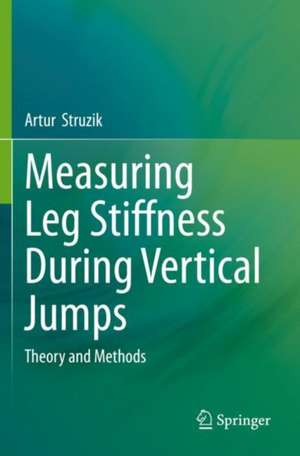Measuring Leg Stiffness During Vertical Jumps: Theory and Methods
Autor Artur Struziken Limba Engleză Paperback – 20 noi 2020
Measuring Leg Stiffness During Vertical Jumps: Theory and Methods is an ideal book for researchers and practitioners in the fields of biomedical engineering, biomechanics, and sport sciences.
Preț: 546.67 lei
Preț vechi: 683.34 lei
-20% Nou
Puncte Express: 820
Preț estimativ în valută:
104.60€ • 113.98$ • 88.15£
104.60€ • 113.98$ • 88.15£
Carte tipărită la comandă
Livrare economică 19-25 aprilie
Preluare comenzi: 021 569.72.76
Specificații
ISBN-13: 9783030317966
ISBN-10: 303031796X
Pagini: 128
Ilustrații: XXI, 128 p. 18 illus., 16 illus. in color.
Dimensiuni: 155 x 235 mm
Ediția:1st ed. 2019
Editura: Springer International Publishing
Colecția Springer
Locul publicării:Cham, Switzerland
ISBN-10: 303031796X
Pagini: 128
Ilustrații: XXI, 128 p. 18 illus., 16 illus. in color.
Dimensiuni: 155 x 235 mm
Ediția:1st ed. 2019
Editura: Springer International Publishing
Colecția Springer
Locul publicării:Cham, Switzerland
Cuprins
Introduction.- Biomechanical Characteristics of the Countermovement Jump.- Leg Stiffness and Quasi-stiffness.- Research Project.- Leg stiffness controversies and interpretations.- Index.
Notă biografică
Artur Struzik is Associate Professor in the Department of Team Sport Games at University School of Physical Education in Wrocław, Poland. He graduated from the Faculty of Physical Education of the University School of Physical Education in Wrocław in 2010. In 2014 he received his Ph.D. degree from the Department of Biomechanics of the University School of Physical Education in Wrocław. He habilitated in the field of sport science in 2018.
He has (co)authored more than 50 publications including 22 peer-reviewed articles in international journals, one book chapter, one popular science work and 28 post-conference reports. Since 2012 he has contributed to 6 national and international projects from public, university and EU funds, 2 of them being coordinated by him. He is engaged as a reviewer for 12 international journals. He is an active member of Polish Society of Biomechanics, European Society of Biomechanics, International Society of Biomechanics in Sports and European Collegeof Sport Science.
His current research focus are on the human motion analysis and sport biomechanics with special interest on vertical jump, muscle elastic properties, plyometric training and antagonist muscle groups strength ratio.
His current research focus are on the human motion analysis and sport biomechanics with special interest on vertical jump, muscle elastic properties, plyometric training and antagonist muscle groups strength ratio.
Textul de pe ultima copertă
This book presents a thorough description and critical discussion of different approaches to measuring leg stiffness during vertical jumps, as well as practical applications. Various topics covered include the applicability of the spring-mass (linear) model of the human motion system, leg stiffness controversies and interpretations, and computational and measuring methods of leg stiffness during vertical jumps. Additionally, a description of a research project performed expressly for inclusion in this book is given; the study aims to determine normative values for leg stiffness for young, healthy, non-athletes during single vertical jumps to maximal and specific heights. A final chapter covers additional perspectives, enabling the reader to acquire different perspectives on measuring leg stiffness during vertical jumps across a breadth of information and interpretations.
Measuring Leg Stiffness During Vertical Jumps: Theory and Methods is an ideal book for researchers and practitioners in the fields of biomedical engineering, biomechanics, and sport sciences.
Measuring Leg Stiffness During Vertical Jumps: Theory and Methods is an ideal book for researchers and practitioners in the fields of biomedical engineering, biomechanics, and sport sciences.
Caracteristici
Standardizes the concepts of leg stiffness found in the literature Provides the theoretical background needed for understanding the measurement of leg stiffness during vertical jumps Illustrates that for vertical jumps to maximal height, "optimal" values of leg stiffness should be used
